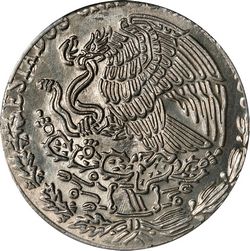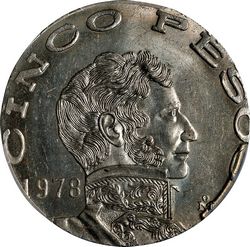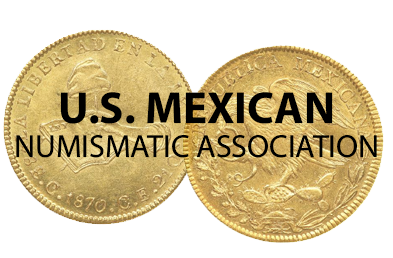Five pesos coins (1905-1908)
The five pesos under the reform of 1905 was made in both gold and silver and later in base metal.
Gold
The gold version was made in one design.


KM-464 1955 $5 gold
This was composed of 90% gold and 10% copper and weighs 4.1666 g. The mintages were:
| Year | Mintage | |
| 1905 | 18,076 | |
| 1906 | 4,638,000 | 4 million pieces were produced by the Philadelphia mint. |
| 1907 | 1,088,000 | |
| 1910 | 100,000 | |
| 1918 | 609,000 | |
| 1919 | 506,000 | |
| 1920 | 2,384,598 | |
| 1955 Restrike | 1,764,643 |
Overdates
Two overdates are 1907 7 over 6 and 1918 8 over 7.


KM-464 1907 overdate 7 over 6 (Stack’s-Bowers Baltimore Auction, November 2015, lot 42645)


KM-464 1918 8 over 7 overstrike (Stack’s-Bowers NYINC auction, 15 January 2019, lot 43676)
“A choice example of this popular overdate with the remnants of the 7 poking out from the top of the 8 like devil horns”.
Non-gold
The non gold 5 pesos was produced in ten basic Types as follows:
Type 1 Cuauhtémoc
Type 2 Railroad
Type 3 Hidalgo
Type 4 Hidalgo/Wreath
Type 5 Hidalgo Chico
Type 6 Constitution
Type 7 Carranza
Type 8 Guerrero
Type 9 Quetzalcóatl Type 9 Quetzalcóatl
Type 10 reduced size
Type 1 Cuauhtémoc
On 11 September 1947 Miguel Alemán changed the specifications for the 50c, $1 and $5 silver coinsDiario Oficial de la Federación, Tomo CLXIV, Núm. 16, 19 September 1947


KM-465 1948 $5
This coin was composed of 90% silver and 10% copper, the diamter was 40 mm and the weight 30g. The mintage was 5,110,000 in 1947 and 26,740,000 in 1948.
“The exchange rate crisis of the Alemán presidency lasted for a little more than 10 months, from July 1948 to June 1949. In a first stage, until April 1949, the exchange rate was allowed to fluctuate around 7 pesos without the balance of payments showing signs of correction (previously the parity was at 4.85 pesos). Unsuccessfully, the price was allowed to advance to 8 pesos. The first loss of reserves began in late 1946. Finally, in mid-1949, according to the International Monetary Fund, a new parity was set at 8.65 pesos per dollar.
Such a sharp exchange rate adjustment had a very damaging effect on silver coins with denominations of 1 and 5 pesos and fineness respectively of 0.500 and 0.900, which were created in 1947. Thanks to the devaluation of the national currency, the intrinsic value of these species far exceeded their face value. That is, since silver was priced in dollars, these pieces acquired a higher value for their metal content than for their face value.” Eduardo Turrent, The Tests of the Mexican Currency of the Twentieth Century.
Type 2 Railroad


KM-466 1950 $5
This coin, which was authorised on 27 October 1950Diario Oficial de la Federación, Tomo CLXXXIII, Núm. 20, 24 November 1950 commemorates the opening of the Ferrocarril del Sureste (Southeasten Railroad) with a depiction of a locomotive passing a plantation.
In the early 20th century the railways in Yucatán were used mainly to carry freight from the plantations to the ports on the peninsula and were not connected to the lines in the rest of the country. In 1930s under the Lázaro Cárdenas administration a huge infrastructure project was initiated to link the nation's railways to the isolated Ferrocarriles Unidos de Yucatán. The result, the Ferrocarril del Sureste, was completed in 1950 and inaugurated by then president Miguel Alemán.
This was also composed of 90% silver and 10% copper. with a diameter of 40 mm and weight of 30 g. The designer was Manuel L. Negrete.
The mintage was 200,000 in 1950. An additional 100,000 were melted down for the 1968 Olympic Games coin.
Type 3 Hidalgo


KM-468 1953 $5 (Stack’s-Bowers auction, 3 September 2025, lot 45673)
This coin, celebrating the 200th birthday of Hidalgo, was composed of 72% silver and 28% copper and weighs 27.777 g. Diameter was 40 mm.
The mintage was 1,000,000 in 1953.
With the new devaluation of the peso in 1954, many of these coins were melted down for their value in silver. In addition, because the design includes the parish church at Dolores Hidalgo, many people in the 50s, 60s and 70s used to relate this coin to Catholicism and religious festivals for which they gave it as a keychain, jewel, etc. Or they plated it in gold or modified it.
Type 4 Hidalgo/Wreath
On 27 October 1950 Miguel Alemán gave the specification of a new $5 coins with the bust of Miguel Hidalgo surrounded by a laurel wreathDiario Oficial de la Federación, Tomo CLXXXIII, Núm. 20, 24 November 1950.


KM-467 1954 $5 (Stack’s-Bowers auction, 28 February 2025, lot 77543)
This was again was composed of 72% silver and 28% copper, with a diameter of 40 mm and weight of 27.777 g.
The snake on the 1951, 1952 and 1953 coins is struck with or without a tongue.


KM-467 1951 $5 snake with tongue (Stack’s-Bowers auction, 16 May 2025, lot 76593)


KM-467 1951 $5 snake without tongue (Stack’s-Bowers auction, 28 February 2025, lot 77541)
The mintages were:
| Year | Mintage |
| 1951 | 4,985,000 |
| 1952 | 9,595,000 |
| 1953 | 20,376,000 |
| 1954 | 30,000 |
In 1953, the economic deterioration, which had been beginning since 1952, continued. This caused in a short time, a flight of capital of considerable magnitude, by 1954. In April 1954 the alteration of the exchange parity of $8.65 to $12.50 was announced, a devaluation of 44%. In reality, this devaluation was planned and stimulated by the government, they preferred to execute it themselves … as a preventive measure since the monetary reserve was registering lower and lower amounts.” Eduardo Turrent, The Tests of the Mexican Currency of the Twentieth Century. This devaluation ment that only 30,000 pieces were minted in 1954, which were quickly withdrawn from circulation.
Type 5 Hidalgo Chico
On 13 September 1955 Adolfo Ruiz Cortines issued a decree giving the characteristics of new coins of 1c, 5c, 10c, 20c, 50c $1, $5 and $10Diario Oficial, 15 September 1955.


KM-469 1955 $5
These had a legend instead of a wreath. They were composed of 72% silver and 28% copper. The diameter was 36 mm and weight 18.055 g. The mintages were:
| Year | Mintage |
| 1955 | 4,271,000 |
| 1956 | 4,596,000 |
| 1957 | 3,464,000 |
Type 6 Constitution
In 1957, in accordance with a decree of 26 December 1956, the government commemorated the 100th anniversary of the 1857 Constitution with $1, $5 and $10 coins in the sane design. The $5 was 72% silver and 28% copper, had a diameter of 36 mm and weighed 18.05 g.


KM-470 1957 $5
The mintage was 200,000 in 1957.
Type 7 Carranza
On 19 December 1959 Adolfo López Mateos authorised $5,000,000 in $5 coins to commemorate the anniversary of the birth of Venustiano CarranzaDiario Oficial de la Federación, Tomo CCXXXVII, Núm. 43, 22 December 1959.


KM-471 1959 $5
The mintage was 1,000,000 in 1959.
Type 8 Guerrero
It took more than ten years for the $5 coin to return. On 27 December 1969 Gustavo Díaz Ordaz issued a decree listing the specifications for a new series of coinsDiario Oficial, 30 December 1969.


KM-472 1973 $5
KM-472 1976 small date (open 9 and 6)
KM-472 1976 large date (closed 9 and 6)
This is composed of 75% copper and 25% nickel, has a diameter of 33 mm and weighs 15 g. The mintages were:
| Year | Mintage |
| 1971 | 28,457,000 |
| 1972 | 75,000,000 |
| 1973 | 19,405,000 |
| 1974 | 34,500,000 |
| 1976 (small date) | 26,121,000 |
| 1976 (large date) | 121,550,000 |
| 1977 | 102,000,000 |
| 1978 | 25,700,000 |
Mint error


KM-474 1978 $5 mint error (Stack’s-Bowers auction, 12 September 2023, lot 73513)
“Quite an intriguing mint error that occurs when a Peso planchet somehow makes its way into the hopper and striking chamber intended for 5 Pesos pieces. As a result of the flan being too small, much of the outer legends are cut off, producing a dramatic and distinctive effect.”
Type 9 Quetzalcóatl


KM-485 1983 $5
This was composed of 75% copper and 25% nickel and weighs 10.36 g. The mintages were:
| Year | Mintage | |
| 1980 | 266,900,000 | |
| 1981 | 30,500,000 | The Royal Canadian Mint minted the entire 30.5 million pieces. |
| 1982 | 20,000,000 | |
| 1984 | 16,300,000 | |
| 1985 | 76,900.000 |
The 5-peso Quetzalcoatl coin was the first coin minted with the sculptural relief in the National Coat of Arms, by Alfonso Rodríguez Facio.
Proofs
Proofs were produced in 1982 (1,048) and 1983.
Type 10 reduced size
On 9 November 1983 Miguel de la Madrid authorised changes in the specifications of coins from $1 to $100 and introduced new $2 and $200 coinsDiario Oficial, 30 December 1983.


KM-502 1985 $5
This was of a smaller size and a new aluminum bronze composition, with a simple $5 design. It is composed of 92% copper, 6% aluminum and 2% nickel and weighs 3.12 g. The mintages were:
| Year | Mintage |
| 1985 | 30,000,000 |
| 1987 | 81,900,000 |
| 1988 | 76,600,000 |
Proofs
Two proofs are known for 1988.
